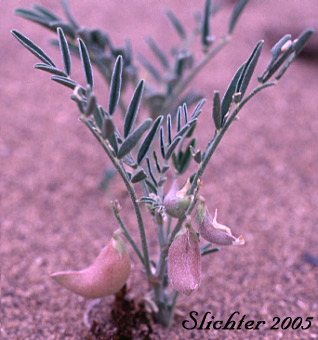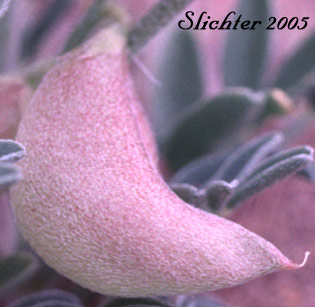
 The
photo at right shows a close-up of the inflated, arched pod of Geyer's milk-vetch
as seen in sand dunes about 1 mile northwest of Borax Lake in the Alvord Basin
of southeastern Oregon............May 28, 2000. Note that the pod is covered
by numerous, minute, appressed hairs.
The
photo at right shows a close-up of the inflated, arched pod of Geyer's milk-vetch
as seen in sand dunes about 1 mile northwest of Borax Lake in the Alvord Basin
of southeastern Oregon............May 28, 2000. Note that the pod is covered
by numerous, minute, appressed hairs.Geyer's milk-vetch is an annual wildflower with stems freely branched from the base measuring 6-25 cm high. The herbage of the stems and leaves consists of appressed white hairs. The pinnately compound leaves are 6-10 cm long with 9-15 leaflets measuring 7-16 mm long and narrowly linear to oblong in outline. The leaflet blades are sparsely haired or sometimes nearly glabrous above while the ventral surface is sparsely to densely haired below.
The flower stem is much shorter than the leaves and topped by a short spike of 3-10 flowers. The calyx is bell-shaped and about 3 mm long with triangular teeth that are shorter than the tube. The whitish corolla is about 6 mm long with light purplish veins or sometimes purple with a white eyespot. The banner measures 5-7.5 mm long and is only slightly reflexed away from the axis of the keel and wings. The wings are 4-6.5 mm long and the keel is 3.8-5 mm long. The spreading to reflexed pods are 12-18 mm long and inflated, with the skin becoming membranous. The pods are completely 1-chambered and either glabrous or covered with straight, stiff, sharp appressed hairs.
Geyer's milk-vetch may be found in sandy deserts, especially on dunes. It is also found in gullies and washes and on the edges of alkaline sandy playas.
Geyer's milk-vetch may be found from southeastern Oregon south to California and Nevada and eastward through the Snake River Plains of southern Idaho to Wyoming and Utah.
